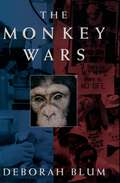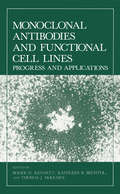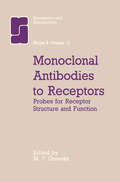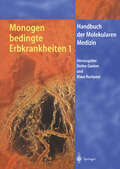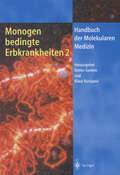- Table View
- List View
Monitoring Tools for Setting up the Hospital Project: Initial Planning, Building and Equipment
by Ajay GargThe hospital buildings are one of the most complex buildings/projects to plan, design, build, and operate. Hospital project planning involves site selection, Detailed Project Report (DPR) preparation, feasibility studies, room planning, hospital building zoning, and construction. This book provides in-depth knowledge and synchronization of the operational policies, licensing, services, equipment procurement, workforce recruitment, and establishing the set of Standard Operating Procedures (SOPs) before the start of hospital operations. This book helps enlighten site engineers and various in-charges to plan their hospital projects efficiently, completing all the jobs and activities well in time. This book narrates all the relevant issues and details about the hospital planning and construction activities in a tabular form and explains each activity extensively. Moreover, the tables provided in the book will also help the planners and executors assess the activity's progress and the person responsible for it. The key feature of the book is a very easily understandable English language that provides the best understanding to the students of Hospital Management, Para Medical Sciences, Architecture, Site Engineers, Site Supervisors, Hospital Promoters, Planners, and Designers.
The Monk: The brand new twisty must-read thriller featuring an unforgettable detective (A DS Cross Thriller)
by Tim Sullivan'I am insanely in love with George Cross' Stephen Fry To find a murderer, you need a motive . . .THE DETECTIVE DS George Cross has always wondered why his mother left him when he was a child. Now she is back in his life, he suddenly has answers. But this unexpected reunion is not anything he's used to dealing with. When a disturbing case lands on his desk, he is almost thankful for the return to normality.THE QUESTION The body of a monk is found savagely beaten to death in a woodland near Bristol. Nothing is known about Brother Dominic's past, which makes investigating difficult. How can Cross unpick a crime when they don't know anything about the victim? And why would someone want to harm a monk?THE PAST Discovering who Brother Dominic once was only makes the picture more puzzling. He was a much-loved and respected friend, brother, son – he had no enemies. Or, at least, none that are obvious. But looking into his past reveals that he was a very wealthy man, that he sacrificed it all for his faith. For a man who has nothing, it seems strange that greed could be the motive for his murder. But greed is a sin after all...Perfect for fans of M.W. Craven, Peter James and Joy Ellis, The Monk is part of the DS George Cross thriller series, which can be read in any order.'The ultimate conjuring trick: an absorbing plot with an engaging detective I'd follow to the ends of the earth. Just brilliant!' Marion Todd'A brilliantly old-school detective with a modern twist . . . from the complex emotion of his private life to the razor-sharp detail of the police investigation. Spot on!' Russ Thomas'Tim Sullivan's detective, DS George Cross, is autistic. His approach to investigations is unorthodox…he works surprisingly well as a fictional character, processing clues in a way that recalls Poirot's “little grey cells”.' Sunday Times'Another tour de force… If you're looking for a great crime series you can't do much better than this. George Cross is an absolute delight.' Bishop Stortford IndependentWhy readers love George Cross . . .'Compelling, full of twists and turns, I couldn't put this down. Sullivan has created a truly original and endearing detective in George Cross.' Simon McCleave'DS George Cross is as arresting as the cases he solves.' Richard E Grant'The fact that Cross has been diagnosed with autism spectrum disorder makes him just as intriguing as the murder mystery' The Times 'A British detective for the 21st century who will be hard to forget' Daily Mail 'Can't wait for the next in the series!' Reader review
The Monkey Wars
by Deborah BlumThe controversy over the use of primates in research admits of no easy answers. We have all benefited from the medical discoveries of primate research--vaccines for polio, rubella, and hepatitis B are just a few. But we have also learned more in recent years about how intelligent apes and monkeys really are: they can speak to us with sign language, they can even play video games (and are as obsessed with the games as any human teenager). And activists have also uncovered widespread and unnecessarily callous treatment of animals by researchers (in 1982, a Silver Spring lab was charged with 17 counts of animal cruelty). It is a complex issue, made more difficult by the combative stance of both researchers and animal activists. In The Monkey Wars, Deborah Blum gives a human face to this often caustic debate--and an all-but-human face to the subjects of the struggle, the chimpanzees and monkeys themselves. Blum criss-crosses America to show us first hand the issues and personalities involved. She offers a wide-ranging, informative look at animal rights activists, now numbering some twelve million, from the moderate Animal Welfare Institute to the highly radical Animal Liberation Front (a group destructive enough to be placed on the FBI's terrorist list). And she interviews a wide variety of researchers, many forced to conduct their work protected by barbed wire and alarm systems, men and women for whom death threats and hate mail are common. She takes us to Roger Fouts's research center in Ellensburg, Washington, where we meet five chimpanzees trained in human sign language, and we visit LEMSIP, a research facility in New York State that has no barbed wire, no alarms--and no protesters chanting outside--because its director, Jan Moor-Jankowski, listens to activists with respect and treats his animals humanely. And along the way, Blum offers us insights into the many side-issues involved: the intense battle to win over school kids fought by both sides, and the danger of transplanting animal organs into humans. "As it stands now," Blum concludes, "the research community and its activist critics are like two different nations, nations locked in a long, bitter, seemingly intractable political standoff....But if you listen hard, there really are people on both sides willing to accept and work within the complex middle. When they can be freely heard, then we will have progressed to another place, beyond this time of hostilities." In The Monkey Wars, Deborah Blum gives these people their voice.
The Monkey Wars
by Deborah BlumThe controversy over the use of primates in research admits of no easy answers. We have all benefited from the medical discoveries of primate research--vaccines for polio, rubella, and hepatitis B are just a few. But we have also learned more in recent years about how intelligent apes and monkeys really are: they can speak to us with sign language, they can even play video games (and are as obsessed with the games as any human teenager). And activists have also uncovered widespread and unnecessarily callous treatment of animals by researchers (in 1982, a Silver Spring lab was charged with 17 counts of animal cruelty). It is a complex issue, made more difficult by the combative stance of both researchers and animal activists. In The Monkey Wars, Deborah Blum gives a human face to this often caustic debate--and an all-but-human face to the subjects of the struggle, the chimpanzees and monkeys themselves. Blum criss-crosses America to show us first hand the issues and personalities involved. She offers a wide-ranging, informative look at animal rights activists, now numbering some twelve million, from the moderate Animal Welfare Institute to the highly radical Animal Liberation Front (a group destructive enough to be placed on the FBI's terrorist list). And she interviews a wide variety of researchers, many forced to conduct their work protected by barbed wire and alarm systems, men and women for whom death threats and hate mail are common. She takes us to Roger Fouts's research center in Ellensburg, Washington, where we meet five chimpanzees trained in human sign language, and we visit LEMSIP, a research facility in New York State that has no barbed wire, no alarms--and no protesters chanting outside--because its director, Jan Moor-Jankowski, listens to activists with respect and treats his animals humanely. And along the way, Blum offers us insights into the many side-issues involved: the intense battle to win over school kids fought by both sides, and the danger of transplanting animal organs into humans. "As it stands now," Blum concludes, "the research community and its activist critics are like two different nations, nations locked in a long, bitter, seemingly intractable political standoff....But if you listen hard, there really are people on both sides willing to accept and work within the complex middle. When they can be freely heard, then we will have progressed to another place, beyond this time of hostilities." In The Monkey Wars, Deborah Blum gives these people their voice.
Monoamine Oxidase: Methods and Protocols (Methods in Molecular Biology #2558)
by Claudia BindaThis detailed book examines the main methods to study mammalian monoamine oxidases (MAOs), ranging from cell biology to computational chemistry. Beginning with techniques on how to obtain pure samples of MAO A and MAO B, the volume continues by covering assays and techniques used to measure MAO enzymatic activity and perform inhibition studies, methods to address cellular localization and function of MAOs, either in cell lines or in animal models, as well as computational methods applied to rational drug design approaches that are used to develop new MAO inhibitors. Written for the highly successful Methods in Molecular Biology series format, chapters include introductions to their respective topics, lists of the necessary materials and reagents, step-by-step and readily reproducible laboratory protocols, and tips on troubleshooting and avoiding known pitfalls. Authoritative and practical, Monoamine Oxidase: Methods and Protocols serves as a vital resource for scientists who are interested in studying MAOs and other similar amine oxidase enzymes.
Monoamine Oxidase Enzymes: Review and Overview (Journal of Neural Transmission. Supplementa #23)
by Lars Oreland and Brian A. CallinghamThe papers in this volume are the invited lectures at the Second Workshop on Amine Oxidases held at the Biomedical Center, Uppsala University, 2 to 4 August 1986. It was a great pleasure for the organizers to see, in Uppsala, so many old and new friends, all brought together by our common interest in the fascinating field of Amine Oxidases. The Workshop was the successor of a long row of successful predecessors to start with the 1972 meeting in Cagliari, Sardinia, and recently preceded by the first meeting of Workshop design, held in Cambridge 1984. Several of the previous meetings have been dedicated to distinguished senior research workers within the field. To start this Workshop a memorial lecture was given. This lecture, given by Prof. T. P. Singer, was dedicated to the late Prof. K. Kamijo, who was one of the pioneers of what is now worldwide interest in Amine Oxidases and who organized the superb meeting in Hakone 1981. To the great honour of all the participants the family of the late Prof. Kamijo visited the Workshop. Abstracts of all the presentations have been published as a Supplement of Acta Pharmacologica et Toxicologica (Copenhagen).
Monoaminergic Modulation of Cortical Excitability
by Kuei-Yuan Tseng Marco AtzoriThis book provides a comprehensive, integrated comparison of the complex modulatory action of dopamine, noradrenaline, and serotonin receptors in the cortex. The discussion assembles a range of opinions on how the monoamine systems affect cortical function. The complexity of these interactions is discussed in light of recent data showing the dramatic effect of disruption of these systems on memory formation and information processing in the cortex.
Monoclonal Antibodies: Methods and Protocols (Methods in Molecular Biology #378)
by Maher AlbitarThis book examines a collection of state-of-the-art methods that employ monoclonal antibodies in a clinical setting. The chapters offer in-depth description for generating mouse and recombinant humanized antibodies, and a comprehensive review of how antibodies are being used in bead-based methods for measuring proteins. This field will continue to expand and provide new and innovative techniques in the laboratory and as a basis that complements targeted therapy.
Monoclonal Antibodies (Springer Lab Manuals)
by R. GieselerThe present new version of this popular laboratory manual is at the same time the first one of this text in the English language - and this makes me even a little proud, as it reminds me of probably the first collection of monoclonal recipes in English, written by myself, which circulated for a couple of years in many laboratories. In the meantime many researchers have put enormous effort into improving methods for monoclonal antibody production. The proce dures have become more and more standardized and by this have more and more lost the character of magic secrets. Hinrich Peters and Horst Baumgarten, who had followed this good tradition already in the previous edition, written in German, suc ceeded in making laboratory tricks teachable. They had contributed their own experiences in cell culture and immunology, and were able to engage a number of experienced authors to contribute to the work. They were all willing to follow the general concept of this book, which contains a brief theoretical background for the methods described and presents the procedures in a highly organized structure. So the book has retained its shape as a "cook-book", which I especially like.
Monoclonal Antibodies: Hybridomas: A New Dimension in Biological Analyses
by Roger H. KennettOn August 7, 1975, Kohler and Milstein published in Nature (256:495) a report describing "Continuous cultures of fused cells secreting antibody of predefined specificity. " Their report has become a classic and has already had a profound effect on basic and applied research in biology and medicine. By the time the first Workshop on Lymphocyte Hybridomas (Current Topics in Microbiology and Im munology 81, 1978) was held on April 3-5, 1978, in Bethesda, Maryland, investi gators from many laboratories had made hybrids between plasmacytomas and spleen cells from immunized animals and had obtained monoclonal antibodies reacting with a broad variety of antigenic determinants. At the time Kohler and Milstein introduced this new technology, the editors of this volume were involved in the production of antisera against differentiation antigens (K. B. B. ), histocompatibility antigens (T. ]. McK. ), and human tumor associated antigens (R. H. K. ). Because of the potential usefulness of monoclonal antibodies in these areas, we each began production of hybridomas and analysis of the resulting monoclonal reagents. One of the most interesting aspects of participation in the early stages of the development and application of hybrid oma technology has been observing how the implications of the initial observa tions gradually spread first among the practitioners of immunology and immu nogenetics, and then to other areas of the biological sciences, such as developmental biology, biochemistry, human genetics, and cell and tumor biology.
Monoclonal Antibodies: Methods and Protocols (Methods in Molecular Biology #1131)
by Vincent Ossipow and Nicolas FischerMonoclonal Antibodies: Methods and Protocols, Second Edition expands upon the previous edition with current, detailed modern approaches to isolate and characterize monoclonal antibodies against carefully selected epitopes. This edition includes new chapters covering the key steps to generate high quality monoclonals via different methods, from antigen generation to epitope mapping and quality control of the purified IgG. Chapters are divided into four parts corresponding to four distinct objectives. Part I covers monoclonal antibody generation, Part II deals with monoclonal antibody expression and purification, Part III presents methods for monoclonal antibody characterization and modification, and Part IV describes selected applications of monoclonal antibodies. Written in the highly successful Methods in Molecular Biology series format, chapters include introductions to their respective topics, lists of the necessary materials and reagents, step-by-step, readily reproducible laboratory protocols, and tips on troubleshooting and avoiding known pitfalls.Authoritative and practical, Monoclonal Antibodies: Methods and Protocols, Second Edition provides crucial initial steps of monoclonal antibody generation and characterization with state-of-the art protocols.
Monoclonal Antibodies and Breast Cancer: Proceedings of the International Workshop on Monoclonal Antibodies and Breast Cancer San Francisco, California — November 8–9, 1984 (Developments in Oncology #35)
by Roberto L. CerianiBreast cancer, being a disease with very high prevalence in the female population, has permanently attracted the attention of biologists, biochemists, pathologists, surgeons, and oncologists. In the U.S. alone approximately 120,000 new cases are diagnosed and 37,000 deaths a year are recorded as an outcome. Early diagnosis, clear cut prognosis and the hope of new therapeutic approaches has spurred the enthusiasm of researchers, who with the advent of newer methodologies, tried to employ it in different approaches to the breast cancer patient. In spite of the efforts devoted towards the creation of new approaches, reagents and procedures taking advantage of special characteristics of the breast tissue were slow to come. In general, most diagnostic and prognostic techniques were those shared and applied to other carcinomas. In the early seventies we discovered the first sets of antigens associated with breast epithelial tissue both in the mouse and the human. The recognition of such group of molecules, present in the milk fat globule membrane, gave impetus to several studies in these areas. These mammary cell surface antigens proved useful in several diagnostic approaches such as radioimaging, histochemical and serum assay procedures. However, the apparently inherent limitations of polyclonal antibodies reduced the impact of these novel approaches.
Monoclonal Antibodies and Functional Cell Lines: Progress and Applications
by Roger H. KennettThis volume serves as a follow-up to our previous book, MonoclonalAntibodies Hybridomas: A New Dimension in Biological Analyses. We continue the theme of monoclonal antibodies and their applications, attempting to cover some of the areas not covered in the previous volume. We again include an appendix de scribing methods useful to those who ar-e beginning to apply these techniques in their own laboratories. This volume will be followed by another concentrating on the combination of monoclonal antibody techniques with molecular genetic techniques to study structure/function relationships at the level of both the gene and gene product. Roger H. Kennett Kathleen B. Bechtol Philadelphia, Pennsylvania Thomas J. McKearn Princeton, New Jersey IX Acknowledgments Roger Kennett acknowledges the patience and support of his wife, Carol, and his family, friends, and colleagues during the work on this volume, and again thanks, above all, the Lord, Jesus Christ. Kathleen Bechtol wishes to thank colleagues and friends for their support and understanding during the months of preparation of this volume. Tom McKearn acknowledges and thanks his wife, Pat, and his family for their support and encouragement. Xl Contents PART I INTRODUCTION 1 Introduction: Reflections on Nine Years of Monoclonal Antibodies from Hybridomas 3 ROGER H. KENNETT, KATHLEEN B. BECHTOL, AND THOMAS J. McKEARN 1. Biotechnology'S "Coming of Age". . . . . . . . . . . . . . . . . . . . . . . . . . . . . . . . . . . . . . . . . . . . . . . 3 II. Monoclonal Antibodies-An Overview of Applications. . . . . . . . . . . . . . . . . . . . . . . . . . . . 6 III. Commercialization of Monoclonal Antibody Technology.. . . .. ... . .... .... .. . ... . . 10 References. . . . . . . . . . . . . . . . . . . . . . . . . . . . . . . . . . . . . . . . . . . . . . . 13 . . . . . . . . . . . . . . . . . . . . .
Monoclonal Antibodies in Cancer: Monoclonal Antibodies, Lymphokines New Developments In Surgical Oncology And Chemo- And Hormonal Therapy (Contemporary Biomedicine #6)
by Stewart Sell Ralph ReisfeldMonoclonal Antibodies in Diagnostic Immunohistochemistry
by Mark WickThis book describes the methodology of monoclonal antibody-mediated immunohistochemistry, as applied to practical tissue diagnosis. It focuses on human disease and discusses the spectrum of monoclonal antibodies in relation to its utility in solving differential diagnostic problems.
Monoclonal Antibodies in Headache: From Bench to Patient (Headache)
by Antoinette Maassen van den Brink Paolo MartellettiIntended to promote a more appropriate and modern therapeutic approach to migraine management, this book is the first to deal with monoclonal antibodies in this context. Authored by the most respected migraine experts from around the globe and drawing on the lessons learned in both clinical trials and clinical practice, it reviews the current state of knowledge on this important therapeutic innovation, which has produced impressive data in randomized controlled trials, and the efficacy and safety of which have been confirmed in day-to-day real-world use. Given its scope, the book will appeal to a broad range of specialists, including pharmacologists, clinical pharmacologists, neurologists and internists, but also to residents and medical students.
Monoclonal Antibodies in Transplantation (Medical Intelligence Unit)
by Lucienne ChatenoudExperimental and clinical evidence presented in this book illustrates that antibodies expressing different specificities can be very effective in preventing or reversing established transplant rejection. Moreover, the data leads us to hope that the use of these new therapeutic agents may allow the induction of specific tolerance to transplant alloantigens which is the only means to avoid the major risks of sustained immunosuppression, namely an increased susceptibility to infection and tumor development. In this volume the editors combine contributions dealing with very practical aspects of the clinical use of monoclonal antibodies with a more general discussion on the developments one may foresee in the near future.
Monoclonal Antibodies to Receptors: Probes for Receptor Structure and Funtcion (Receptors and Recognition #17)
by M. F. GreavesMonoclonal Antibody Protocols (Methods in Molecular Biology #45)
by William C. DavisSince the initial description of techniques to immortalize anti body-producing B-lymphocytes by fusion with tissue culture-adapted myeloma cells, methods have been developed to produce monoclonal antibodies of defined specificity in multiple animal species. Stable hybrids can be readily produced in mice using a number of myeloma and hybridoma cell lines. To obviate the problem of identifying fusion partners in other animal species, xenohybrids have been produced using B-lymphocytes from the relevant species and mouse myeloma cells. The use of xenohybrids has minimized the problem of obtain ing stable antibody-producing hybrids in all species examined thus far. Although alternative techniques are being developed to produce monoclonal antibodies by molecular methods, hybridoma technol ogy will remain the technology of choice for producing monoclonal antibodies for a variety of applications in research and industry. The objective of Monoclonal Antibody Protocols is to provide investigators with a set of methods for producing and using mono clonal antibodies in biomedical, agricultural, and biological sciences. The book is not intended to provide methodology for all possible applications, but rather a series of methods presented in an easy-- follow format that can be used by new and established investiga tors, graduate and postgraduate fellows, and technical staff.
Monoclonal Antibody Therapy of Human Cancer (Developments in Oncology #38)
by Alton C. Morgan Kenneth A. FoonMonogen bedingte Erbkrankheiten 1 (Handbuch der Molekularen Medizin #6)
by Detlev Ganten Klaus RuckpaulVererbbare Krankheiten sind erst seit wenigen Jahren Forschungsgegenstand der molekularen Medizin. Das Handbuch faßt die aktuellen Erkenntnisse zusammen und behandelt praxisgerecht die modernen gentechnischen Möglichkeiten der Diagnostik und Therapie. Dabei reicht das Themenspektrum von neuromuskulären Erkrankungen bis hin zu Repeat-Sequenz-Expansions-Syndromen.An Ihren klinischen Belangen orientiert:- Gegenüberstellung konventioneller und molekularmedizinischer Therapiestrategien- Interpretation der Forschungsergebnisse- verständliche Einführung in moderne gentechnische Methoden Das Handbuch bietet Ihnen hochaktuelles Wissen, das Ihren medizinischen Alltag zunehmend bestimmen wird.
Monogen bedingte Erbkrankheiten 2 (Handbuch der Molekularen Medizin #7)
by Detlev Ganten Klaus RuckpaulDer Band eröffnet den Zugang zu einem faszinierenden Gebiet der molekularen Medizin. Anerkannte Experten stellen umfassend die modernen Erkenntnisse über die molekularen Grundlagen von Erbkrankheiten dar:Wissenschaftlich fundiert- Erkrankungen der Augen, der Mundhöhle und des Kiefers, der Haut und des Skelettsystems bis zu erblichen NierenerkrankungenPraxisorientiert- Wichtige Aspekte bei der Beratung von betroffenen Patienten- Aktueller Stand der GentherapieDamit ergänzt der Band die Darstellung monogen bedingter Erbkrankheiten in Band 6.Das Werk macht eindrucksvoll die Fortschritte gendiagnostischer Analysen und die Möglichkeiten einer vorsorgenden Therapie deutlich.
Monographs in Contact Allergy: Fragrances and Essential Oils (Monographs in Contact Allergy #2)
by Anton C. de GrootThis second volume in an exciting and detailed series on contact allergens provides monographs of all 181 fragrances and 79 essential oils which have caused contact allergy / allergic contact dermatitis, including the indicators for fragrance allergy (fragrance mixes I and II and Myroxylon pereirae resin [Balsam of Peru]) and non-fragrance allergens in botanical products used in the perfume industry. The monographs present: Identification section; Contact allergy (general population, patients with dermatitis, case reports and case series); Cross-reactions; Patch test sensitization; Presence in products and chemical analyses; Other side effects (irritant contact dermatitis, photosensitivity, immediate-type reactions, systemic side effects) and more. Key Features: Presents monographs of all known fragrance chemicals and essential oils which have caused contact allergy / allergic contact dermatitis Provides a full literature review of relevant topics of allergenic fragrances and essential oils Identifies INCI and IUPAC names, synonyms, CAS and EC numbers, structural formulas, RIFM and Merck Index monographs, SCCS opinions, IFRA and EU restrictions and advises on patch testing Presents an alphabetical list of all synonyms indicating their INCI names Covers an extensive amount of information to benefit dermatologists, allergists, and non-medical professionals involved with the research, development and marketing of fragrances and essential oils
Monographs in Contact Allergy: Fragrances and Essential Oils (Monographs in Contact Allergy #2)
by Anton C. de GrootThis second volume in an exciting and detailed series on contact allergens provides monographs of all 181 fragrances and 79 essential oils which have caused contact allergy / allergic contact dermatitis, including the indicators for fragrance allergy (fragrance mixes I and II and Myroxylon pereirae resin [Balsam of Peru]) and non-fragrance allergens in botanical products used in the perfume industry. The monographs present: Identification section; Contact allergy (general population, patients with dermatitis, case reports and case series); Cross-reactions; Patch test sensitization; Presence in products and chemical analyses; Other side effects (irritant contact dermatitis, photosensitivity, immediate-type reactions, systemic side effects) and more. Key Features: Presents monographs of all known fragrance chemicals and essential oils which have caused contact allergy / allergic contact dermatitis Provides a full literature review of relevant topics of allergenic fragrances and essential oils Identifies INCI and IUPAC names, synonyms, CAS and EC numbers, structural formulas, RIFM and Merck Index monographs, SCCS opinions, IFRA and EU restrictions and advises on patch testing Presents an alphabetical list of all synonyms indicating their INCI names Covers an extensive amount of information to benefit dermatologists, allergists, and non-medical professionals involved with the research, development and marketing of fragrances and essential oils


